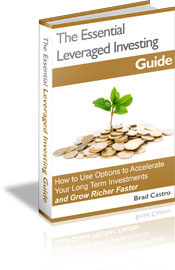Leveraged Investing:
No Substitute for Planting a Tree
What is Leveraged Investing?

The short answer is that Leveraged Investing is the strategic use of options to enhance your long term investments, allowing you to acquire quality assets at significant discounts and generating additional returns on those assets year in and year out.
The specific strategies are spelled out in The Essential Leveraged Investing Guide.
The long version is a little more involved . . .
The genesis of this approach came from a particular method of option trading that I called The Triple Play Income Strategy. It was an impressive strategy, if I do say so myself. Employ this strategy and regardless of how the underlying stock behaves, you're going to get paid:
- If the stock goes up, you receive income
- If the stock stays flat, you receive income
- If the stock goes down, your receive income
Not bad, huh? As long as the company you've chosen doesn't suffer a complete meltdown, it's very difficult to shut off the income faucet.
But as I began working with this method and exploring it in greater detail, I found myself bombarded with other ideas, some of them related, others seemingly not. A few of the ideas involved other option trading ideas and customized strategies, but many of the ideas went deeper than mere trading techniques.
The Triple Play Problem
In the end, the biggest drawback to The Triple Play Income Strategy was that it was an option trading strategy and not an option investing strategy.
Not that I actually made that distinction at the time.
Still, there was something not quite satisfying about it. Yes, it was an effective income strategy, as it generated income from all cycles of stock ownership - before, during, and after. But it was never about the actual ownership. Owning stock, even if it were a high quality company, was never the goal. Stock ownership was merely incidental.
And, at some level, I knew it wasn't really investing.
No Substitute
Have you ever had a phrase come to you unexpectedly? Maybe in the morning, upon awakening or shortly afterwards? I'm a writer, so crazy things are always bubbling up.
But one day, what bubbled up was the phrase, There is no substitute for planting a tree.
Our thoughts are never completely our own. We read and listen to what others have to say, find ourselves being influenced by multiple, often conflicting, viewpoints and different perspectives, and then we internalize all these views and ideas and unconsciously simmer them into a new stew of our own authentic thoughts.
And for me, the phrase, There is no substitute for planting a tree, crystallized in one sentence a decade's worth of research, readings, and experience involving investing and trading.
It was my A-ha! moment. I saw how the principles behind The Triple Play Income Strategy could be used - and profoundly so - but from an investing perspective.
I love option trades and option trading. But I've since come to believe - deeply and viscerally - that it's next to impossible to use short term techniques to accumulate long term wealth.
Planting Trees

|
And now, a little Leveraged Investing analogy . . .
An oak tree is one of my favorite things in the whole world. Oak trees are notoriously slow growers, but they more than make up for it by their longevity. And they keep growing, year in and year out. They are nature's living embodiment of the power of compounding interest.What does it take to create a mighty oak of your own?
Very little, it turns out. It just requires an acorn and about five minutes to plant it. If you successfully plant an acorn today and it takes root and begins to grow, you're done. That's it. There's nothing else to do but wait.
Five minutes of effort followed by a couple hundred years of going about your business, and you've got yourself one of nature's great creations.
If Only We Lived a Thousand Years
The problem, of course, is that we don't have two hundred years to wait around for our financial oak trees to grow organically.
We do, however, have more than five minutes at our disposal, but for the majority of us, we expend much of our energy living and trading and investing as though five minutes were all the time we did, in fact, have.
Even though we long for our own grove of mature and mighty oaks, many of us spend our lives trying to figure out how to acquire that grove of two and three hundred year old trees in just two or three years.
Sympathy for the Option Trader
Don't get me wrong. This is not an indictment of short term traders and aggressive option strategies. There's a special place in my heart for the financial risk-taker.
I quietly root for the ambitious, chart-reading, frenetic options player over the properly diversified, mutual funded, Money Magazine passive investor with the maxed out IRAs and company-matched 401K and a year's worth of living expenses tucked safely away in properly laddered CDs.
And why is it that I root for the risk-taking options player? Because I'm a softy. I've always been a sucker for the underdog.
Long Term = Plant a Tree
Short Term = Be a Tree
There is no substitute for planting a tree. The short term trading horizon, I've come to realize, is an attempt to do just that - substitute planting a tree. It's the synthetic version where - and this is crucial to realize - we become the tree. And remember, it's the tree that does all the work.
Obviously, there must be some kind of middle ground. Somewhere between the extremes of five minutes and a quarter of a millennium. Somewhere we can plant genuine oak trees and see them mature in our own lifetime. This is the philosophy, the paradigm, the quest that took the acorn of The Triple Play Income Strategy and nurtured it into an unstoppable Leveraged Investing oak sapling.
There is a profound difference between organic trees and simulated trees, and the clarity of this realization enabled me to focus not on methods to become a better synthetic tree, but rather on methods to speed up the growth cycle of the organic trees all around us.
In short, the conscious decision to stop trying to be a tree and instead strive to become a first-rate forester (a good definition of Leveraged Investing in itself) has profound consequences.
Leveraged Investing vs. Leveraged Trading
Once you become consciously aware that there is a difference between real trees and artificial trees, you quickly grow adept at identifying for yourself which is which. And in the process, you discover an important corollary: not all leverage is created equal.
Leverage - code name for debt and options - frequently gets a bad rap, especially when abuses of leverage are in the headlines.
Overleveraging, of course, is always dangerous and risky. It's like that old question, "Can you get too much of a good thing?" The answer is a resounding yes. What else does "too much" mean?
But just as there are strategic and intelligent uses of debt, there are also strategic and intelligent uses of options.
I think it's safe to say that the majority of options buyers and sellers are leveraged traders. Certainly there is no disgrace in such a distinction. But neither is there a long term mindset or the presence of genuine oak saplings.
What I'm after these days, and the central theme around which this website is organized, is what I call Leveraged Investing. Leveraged Investing attempts to harness the power of option trading not to try to win the lottery, but in the service of a high quality and long term portfolio, a smart and safe way to significantly boost returns over time.
Owning vs. Controlling
The fundamental difference between Leveraged Investing and leveraged trading is the difference between owning and controlling.
Traders use leverage to temporarily gain, or simulate the advantages of, ownership. Traders control an asset for a brief period only. If their strategies are correct and they're fortunate, they can spin out some impressive profits. But if they're wrong, they can lose large sums as well.
The primary benefit of owning an asset rather than gaining temporary control of it is the ability to weather short term problems. Or even intermediate term problems. For the trader, however, if anything goes wrong, time becomes a brutal enemy rather than a compassionate friend.
In almost every case it's better to own something than to pay for the right to control it for a defined period of time (make no mistake - you do pay something in every option trade where you're not the owner, whether it's cash in the form of a debit, or assumed risk in the form of a credit). Option trading is no different than property. It's a whole lot nicer when you're the owner rather than the renter.
The most common obstacle to asset ownership is the cost-prohibitive aspect of acquiring them en masse. In short, it costs a lot of money to get enough of them to live lucratively (or even comfortably). A $10 million portfolio generating safe and consistent 5% returns is vastly more desirable than a $10,000 portfolio that assumes substantial risk as it targets 50% growth each year.
Bridging the Gap with Leveraged Investing

How then can we bridge the gap? How can we grow our own substantial asset-based portfolio from a modest base in less than an entire lifetime? What if we need to do it from scratch? Is any of this even possible?
Questions inevitably lead to answers, and I firmly believe that asking the right questions is the cornerstone to achieving your dreams and your desires.
I have come to believe - as my questions inevitably found their answers - that we bridge the gap between asset-renters and asset-owners by using leverage intelligently and skillfully.
We do so changing our mindset and perspective from that of leveraged trading to that of Leveraged Investing.
That's what I came to realize what Leveraged Investing was really about - not the employment of a single trading strategy or method to wring consistent profits from the stock market, but rather readjusting one's mindset to focus on the construction of a self-sustaining, owner-based, investment empire.
Tweet
Follow @LeveragedInvest
Return from Leveraged Investing: No Substitute to:

>> The Complete Guide to Selling Puts (Best Put Selling Resource on the Web)
>> Constructing Multiple Lines of Defense Into Your Put Selling Trades (How to Safely Sell Options for High Yield Income in Any Market Environment)
Option Trading and Duration Series
Part 1 >> Best Durations When Buying or Selling Options (Updated Article)
Part 2 >> The Sweet Spot Expiration Date When Selling Options
Part 3 >> Pros and Cons of Selling Weekly Options
>> Comprehensive Guide to Selling Puts on Margin
Selling Puts and Earnings Series
>> Why Bear Markets Don't Matter When You Own a Great Business (Updated Article)
Part 1 >> Selling Puts Into Earnings
Part 2 >> How to Use Earnings to Manage and Repair a Short Put Trade
Part 3 >> Selling Puts and the Earnings Calendar (Weird but Important Tip)
Mastering the Psychology of the Stock Market Series
Part 1 >> Myth of Efficient Market Hypothesis
Part 2 >> Myth of Smart Money
Part 3 >> Psychology of Secular Bull and Bear Markets
Part 4 >> How to Know When a Stock Bubble is About to Pop


